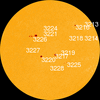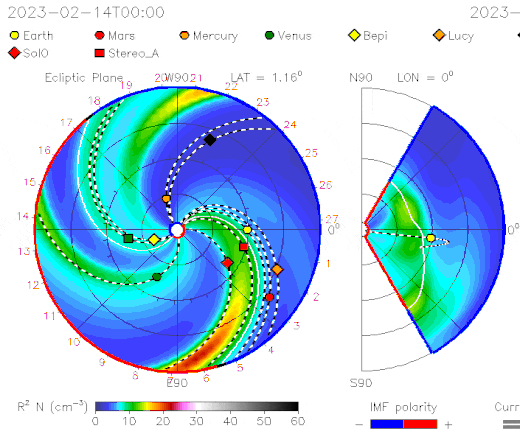SOLAR CYCLE ACTIVITY REPORT FEBRUARY 16/2023
Solar activity has been at moderate levels for the past 24 hours. The largest solar event of the period was a M2 event observed at 15/0523Z from Region 3213 (N28W0)
There are currently 11 numbered sunspot regions on the solar disk: AR3214, AR3216 AR3217, AR3219, AR3220, AR3221, AR3224, AR3225, AR3226, AR3227, AR3228
AR3213, AR3218 are gone
The total number of sunspots has decreased to 140 (42 of these are grouped into 11 active regions) NOAA forecasts for the next 24h: 95% chance for C flares, 45% chance for M flares and 10% chance for X flares.
NOAA reduces its estimate of M- and X-class solar flares because AR3213 has left the solar disk. On the other hand, AR3226 (N11E07) has modified its magnetic complexity to beta-delta that harbors energy for M-class solar flares
● Auroral Activity
The geomagnetic field has been at unsettled to storm levels for the past 24 hours. Solar wind speed reached a peak of 348 km/s at 03:57 UTC on February 15 Minor G1 geomagnetic storm (Kp5) threshold reached: 08:25 UTC Maximum planetary index Kp5
Aurora Oval

● Current Conditions at 06:30 UTC on February 16
▪︎ Geospace unsettled
▪︎Geomagnetic conditions now Kp 3
▪︎Solar wind speed record: 392.5 km/sec
▪︎density: 7.7 p/cm3
▪︎Neutron Counts today: -1.4% Below Average
▪︎X-ray Solar Flare: M1 at 00:32 UTC
▪︎Sunspot number: 140 (SN 206 Feb 15)
SpaceWeather.com
SpaceWeatherlive..com
Solar activity has been at moderate levels for the past 24 hours. The largest solar event of the period was a M2 event observed at 15/0523Z from Region 3213 (N28W0)
A SOLAR EXPLOSION OF INTEREST: A magnetic filament loosely connected to sunspot AR3226 erupted during the early hours of Feb. 15th. NOAA forecasters say the resulting CME is "very likely to hit Earth." SpaceWeather.com
There are currently 11 numbered sunspot regions on the solar disk: AR3214, AR3216 AR3217, AR3219, AR3220, AR3221, AR3224, AR3225, AR3226, AR3227, AR3228
AR3213, AR3218 are gone
The total number of sunspots has decreased to 140 (42 of these are grouped into 11 active regions) NOAA forecasts for the next 24h: 95% chance for C flares, 45% chance for M flares and 10% chance for X flares.
NOAA reduces its estimate of M- and X-class solar flares because AR3213 has left the solar disk. On the other hand, AR3226 (N11E07) has modified its magnetic complexity to beta-delta that harbors energy for M-class solar flares
● Auroral Activity
The geomagnetic field has been at unsettled to storm levels for the past 24 hours. Solar wind speed reached a peak of 348 km/s at 03:57 UTC on February 15 Minor G1 geomagnetic storm (Kp5) threshold reached: 08:25 UTC Maximum planetary index Kp5
CLOSE ENCOUNTER WITH A CME: A coronal mass ejection (CME) passed close to Earth on Feb. 15th. It wasn't a direct hit. Nevertheless, its arrival triggered a minor G1-class geomagnetic storm with auroras in the USA as far south as Montana
The CME (movie) was hurled into space by an erupting magnetic filament (movie) in the sun's northern hemisphere on Feb. 11th. It took 4 days to get here and was somewhat off-target--hence the relatively minor storm.
Aurora Oval
● Current Conditions at 06:30 UTC on February 16
▪︎ Geospace unsettled
▪︎Geomagnetic conditions now Kp 3
▪︎Solar wind speed record: 392.5 km/sec
▪︎density: 7.7 p/cm3
▪︎Neutron Counts today: -1.4% Below Average
▪︎X-ray Solar Flare: M1 at 00:32 UTC
▪︎Sunspot number: 140 (SN 206 Feb 15)
SpaceWeather.com
SpaceWeatherlive..com


